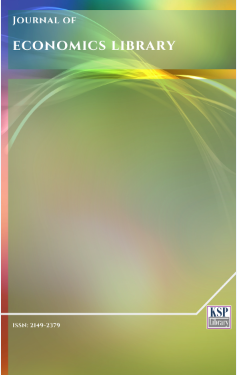The Potential Driving Forces of Wealth Accumulation by South Korea’s Leading Shipbuilding Giants: Wage-Labor Nexus and Dual-channel Capital Accumulation
Abstract
Abstract. This study explores how institutional factors increase the possibility of Korea’s three main shipbuilders’ capital accumulation and what effect institutional factors have on their capital accumulation. By examining the structural features of these shipbuilders’ labor and changes in their wage-labor nexus, the mechanisms of dual-channel capital accumulation are better understood. Ultimately, our findings show that dual-channel capital accumulation, which allows three shipbuilders to secure the practicality of overall loss minimization or overall profit maximization, has been created through the evolution of their labor structure.
Keywords. Dual-channel capital accumulation, Wage–labor nexus, Korean shipbuilders, Structural transformation, Shipbuilding and offshore industry.
JEL. D22, J21, J31, L62.
Keywords
References
Anne, J. (2015). Subcontract structure in the automobile and shipbuilding industry and the differences in working conditions (in Korean). Monthly Labor Review, 126, 38-49.
Gang, S.J. (1998). Wage scheme in shipbuilding industry (in Korean). In S.J. Gang, D.S. Hwang, J.W. Joo, Y.D. Kim, & M.Y. Lee (Eds.), Trade Union and Wage Scheme: Search for Solidarity, (pp. 50-67). Seoul, Korea: Korea Labour and Society Institute.
Kim, W.J. (2013). The evolution of a corporate system: The case of production and employment structures in the Toyota Group. The Kyoto Economic Review, 82(1-2), 31-58.
Kim, W.J. (2014a). An institutional economic approach to the low-cost production system: The wage–labour nexus in Hyundai Motor Group. Evolutionary and Institutional Economics Review, 11(1), 19-40. doi. 10.14441/eier.110102
Kim, W.J. (2014b). The low-cost production system of Hyundai Motor Company in Korea: Focused on the wage-labour nexus (in Japanese). In H. Uemura, H. Uni, A. Isogai, & T. Yamada (Eds.), Asian Capitalisms in Transition (pp.283-302). Tokyo, Japan: Fujiwara-shoten.
Kim, W.J. (2016) Structural features and mechanisms of the Korean powerhouses: What makes these niche companies leaders in the global market?, Journal of Economics and Political Economy, 3(2), 284-308. doi. 10.1453/jepe.v3i2.770
Korean Confederation of Trade Unions, Federation of Korean Trade Unions, & The labor unions of shipbuilding industry, (2016, August 8). The crisis in shipbuilding industry, shipyard workers on the edge of a precipice, and their testimony. Speech presented at testimony seminar in National Assembly of Korea, The National Assembly Members' Office Building, Seminar room 2, Seoul, Korea.
Korean Metal Workers' Union, (2013). Research report on restructuring of shipbuilding industry and labor union’s intervention strategy for the labor market (in Korean) (Working paper). Seoul, Korea: Korean Metal Workers’ Union. Retrieved September 19, 2016. [Retrieved from].
Korean Metal Workers' Union, (2014).The 2014 comparative database of collective bargaining agreements and wage determinations (in Korean). Seoul, Korea: Korean Metal Workers’ Union
Korean Metal Workers' Union, (2015).The 2015 survey on the working conditions of bulk-hired program-specific workers in shipbuilding industry (in Korean) (Working paper). Seoul, Korea: Korean Metal Workers’ Union. Retrieved September 19, 2016, [Retrieved from].
Lee, S.H., &Heo, M.Y. (2009) Report on analysis of the present condition and changes in earned surplus of the 10 biggest chaebols (in Korean)(Working paper). Seoul, Korea: Korean Metal Workers’ Union. Retrieved November 8, 2016. [Retrieved from].
Metal Network Korea, (2008). Present condition and prospect of world wide shipbuilding industry (in Korean). Marine and Shipbuilding for Monthly News, 2, 79-98.
OECD, (2013).Strengthening social cohesion in Korea, Paris. France: OECD Publishing.
OECD, (2014).Peer review of the Korean shipbuilding industry and related government policies. Paris, France: OECD Publishing.
Oh. M.G. (2016, May 8). What has happened to Korea’s shipbuilding industry for the last fifteen years? (in Korean). Pressian. Retrieved October 23, 2016. [Retrieved from].
Park, C. (2015a). Subcontract structure in the shipbuilding industry (in Korean). Monthly Labor Review, 126, 24-37.
Park, J.S. (2015b). The crisis in shipbuilding industry and changes in employment scale: The expected adjustment of employment and the tasks of labor union activities after 2016 (in Korean)(Working paper). Seoul, Korea: Korean Metal Workers’ Union. Retrieved July 17, 2016. [Retrieved from].
The Korea Offshore and Shipbuilding Association, (2016) Development history of Korea’s shipbuilding industry. Retrieved May 11, 2016. [Retrieved from].
The Korea Offshore and Shipbuilding Association, (2010-2016) Shipbuilding Yearbook. Seoul, Korea: The Korea Offshore and Shipbuilding Association. every year from 2010 to 2016.
DOI: http://dx.doi.org/10.1453/jel.v4i1.1227
Refbacks
- There are currently no refbacks.
.......................................................................................................................................................................................................................................................................................................................................
Journal of Economics Library - J. Econ. Lib. - JEL - www.kspjournals.org
ISSN: 2149-2379
Editor: [email protected] Secretarial: [email protected] Istanbul - Turkey.
Copyright © KSP Library

